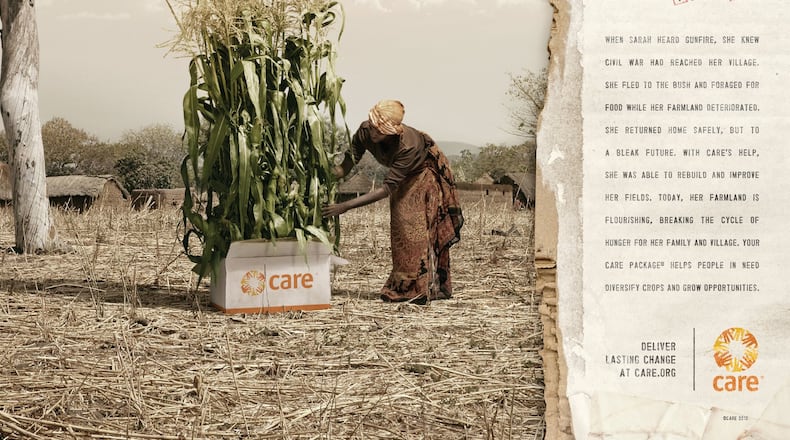There’s a new CARE Package under the tree this holiday season.
CARE, the Atlanta-based relief agency, which pioneered the delivery of food to a devastated Europe following World War II, is reimagining the iconic CARE Package as a 21st century tool of development.
“Now the icon will stand for donations that extend far beyond the confines of a carton,” said Rob Schapiro, the creative director of a marketing agency using the familiar stenciled package.
Magazine ads, billboards and “ambient” ads will tell the story of what CARE accomplishes today. Instead of just food in a box, the new message says CARE delivers lasting change for the better, defined as “empowerment,” “sustainability,” “livelihood,” “tools,” “skills,” “training” and “support.” In one display ad, an entire verdant village spills out of a CARE Package.
One of those “ambient” ads was just installed Monday at Atlantic Station, featuring oversized CARE boxes constructed around the street lamps that illuminate the sidewalks of the mixed-use area.
The point of that installation is that CARE delivers electrical power — and light — to help end poverty.
Many Americans today are familiar with the concept of a CARE Package, but they aren’t aware that it originated with the Atlanta organization.
The first CARE Package was sent in 1946 to Le Havre, France, using surplus canned meat, dried milk, biscuits, jam, raisins, chocolate and cigarettes that had been sitting in a warehouse in the Philippines. The goal: to provide emergency food for Europeans struggling in the aftermath of the war.
There are some Atlantans who will never forget what CARE did to help the victims of that devastation.
Though she was only 5 or 6 years old, Ingrid Hurtubise of Marietta remembers distinctly the butter, corn bread and a brand-new toothbrush that arrived in a CARE Package for her family of six, struggling to grow food on a cold, windswept island at the northern tip of Germany.
Her mother impressed on her to be particularly grateful for the gift of food and supplies sent to her country, even though her country was the one that “brought the war.”
“We got fish oil and all kind of things we needed in order to grow up to be healthy,” said Hurtubise, 72, who owns a company specializing in language translation services.
Mitchell Wirth of Decatur, whose father’s family lived in Berlin after the war, said very plainly, “There was mass starvation going on. … I wouldn’t be around if it wasn’t for CARE.”
Wirth, who has since become a volunteer for CARE, added, “I’m so grateful that the kindness of strangers literally saved my dad and his family’s lives.”
The last CARE Packages were sent overseas in 1968, though the program was briefly revived in the early 1990s to help communities in the former Soviet Union and victims of the civil war in Bosnia.
By then CARE’s approach was focused on development rather than relief, said Tolli Love, the vice president of marketing and fundraising at CARE. “One of the big shifts was that CARE realized they could make a huge difference and really change the game if they worked with families and communities to give them the tools and resources they need to improve their capacity for self-help.”
For example, CARE helps create village savings and loan programs to give small-scale rural entrepreneurs access to capital. The organization also works to give women access to education and political influence, knowing that “if you empower a woman, she will help not only herself and her family, but oftentimes an entire community.”
The CARE Package has bigger things in it now, Love said, though the instinct toward generosity is the same.
A CARE timeline
Nov 27, 1945 — The Cooperative for American Remittances to Europe, or CARE, is created.
May 7, 1946 — President Harry Truman buys 100 CARE Packages for war survivors in Europe, starting a tradition of presidential support for CARE and its mission.
May 11, 1946 — The first CARE Packages are distributed in war-battered Le Havre, France. They had been sitting in a warehouse in the Philippines, stored for an invasion of Japan that never came. Each contained enough food to feed one soldier for 10 days. Contents included meat, dried milk, biscuits, jam, raisins, chocolate, gum and even cigarettes.
1955 — CARE Packages discontinued for European countries deemed recovered. Delivery of CARE Packages expands to other regions in need, including Asia and Latin America.
1963 — “Every CARE Package is a personal contribution to the world peace our nation seeks,” writes President John F. Kennedy, reflecting on the connections created by the CARE Package. “It expresses America’s concern and friendship in a language all people understand.”
1968 — The CARE Package enters retirement with the final shipment of boxes containing tools. The last food packages went out a year earlier. All told, CARE sent 100 million CARE Packages to people in need around the world.
1990-94 — The CARE Package makes a short-term return, as boxes of supplies go to economically depressed republics of the former Soviet Union. CARE, which now stands for Cooperative for Assistance and Relief Everywhere, also delivers CARE Packages to survivors of civil war in Bosnia.
Source: CARE
About the Author
Keep Reading
The Latest
Featured



